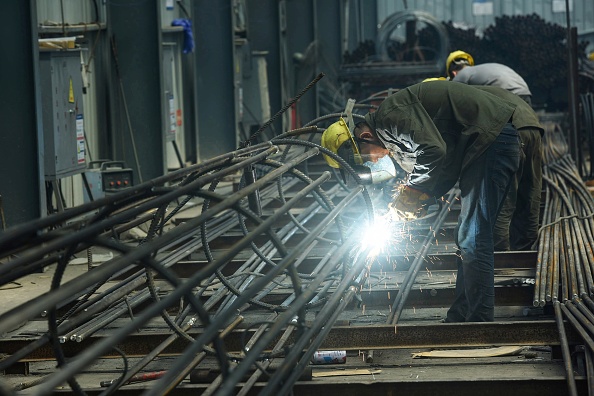
An employee works on steel bars at a factory in Hangzhou, in China’s eastern Zhejiang province on May 15, 2020. (Photo by STR / AFP) / China OUT (Photo by STR/AFP via Getty Images)
By and
It is obvious that China’s economy continues to decline and market demand is weak.
The Manufacturing PMI (Purchasing Managers’ Index) released by the National Bureau of Statistics (NBS) recorded 49.2 in October, down 0.9 percentage points, contracting again; the Services Business Activity Index and the Composite PMI Output Index both plunged 1.9 percentage points, recording 47.0 and 49.0 respectively, both are the lowest since June.
Regarding inflation, input prices rose for the first time in 3 months due to high raw materials prices. Selling prices, on the contrary, fell for the sixth month running, an effort by firms to promote sales.
Overseas demand dropped for the third month in a row, as global cost pressures lingered. Domestic demand is also weak. According to the “Third Quarter Survey of Urban Households Savings” (pdf) released by the People’s Bank of China (PBoC) in October, Chinese residents’ “intentional willingness to save continues to be stronger.” The proportion of residents who prefer to “spend more” decreased by 1.0 percentage point from the second quarter to 22.8 percent. Meanwhile, the Employment Sentiment Index continued to fall to 35.4 percent, the lowest since the third quarter of 2019.
Previous official figures showed that China’s small and medium enterprises contribute more than 50 percent of tax revenue, generate more than 60 percent of GDP, perform 70 percent of technological innovation, provide more than 80 percent of urban labor employment, and account for more than 90 percent of the number of enterprises.
However, the latest data from the China Association of Small and Medium Enterprises (CASME) shows that the China SME Development Index (SMEDI) was 88.3 in August, unchanged from the previous month and lower than the same month last year. This reflects “a lack of business confidence” and “weak market demand.” The SMEDI ranges from 0-200, with 0-100 being the depressed range that indicates declining or deteriorating economic conditions.
China’s macro economy is also continuing its downward spiral. On Oct. 9, the PBoC also released the “Q3 Entrepreneur Survey Report” (pdf), in which the Entrepreneur Macroeconomic Enthusiasm Index continued to decline at 26.9 percent, down 12.9 percentage points from the same period last year, despite a slight increase of 0.4 percent from last quarter, indicating that China’s macro economy as a whole is on the downside in 2022.
In September, several financial institutions lowered their expectations for China’s GDP growth in 2022. The Asian Development Bank lowered its GDP growth forecast for 2022 to 3.3 percent in September, 1.7 percentage points lower than forecast in “Asian Development Outlook 2022.”
On September 29, the World Bank lowered China’s GDP growth to 2.8 percent this year. The Bank said: “The property market slowdown, triggered by regulatory tightening that led to a liquidity squeeze for developers, has further weighed on economic activity. Housing demand remains subdued due to weak homebuyer sentiment amid repeated COVID-19 outbreaks and mortgage boycotts by owners of homes still under construction. ”
On Sept. 30, China Index Holdings (CIH) released its ranking of sales performance by China’s real estate companies from January to September this year. According to the ranking, the average sales volume of the top 100 real estate companies for the first nine months was approximately $7.6 billion, down 45.1 percent year-on-year.
The latest data on China’s real estate sector released by NBS on Sept. 16, showed that China’s real estate development investment fell by 7.4 percent year-on-year in the first eight months, a drop of 1 percentage point from the July figure. In response to a reporter’s question, NBS spokesperson Fu Linghui admitted, “The real estate market is still downward.”
Does the Chinese Communist Party (CCP) have a plan to save the economy?
Chu Hanshi, a veteran of Chinese finance in the UK, told the Epoch Times that a normal country or government could save the economy through political or economic reforms. But the CCP is a totalitarian government, and within it, there are different interest groups, all with vested interests. Any reform is tantamount to “revoking the life of those with vested interests,” which means “revoking the life of the CCP itself.” Therefore, as long as the CCP is in power, there is no way to restore China’s economy.
Regarding the situation that the CCP focuses on political infighting instead of developing economics, Chu Hanshi believes that social conflicts will intensify and public discontent will rise. In order to shift the conflicts and discontent in society, the CCP will probably close the country again, engage in self-reliance domestically, or even make a desperate attempt to attack Taiwan by force. But no matter what they do, the CCP is accelerating its own demise.